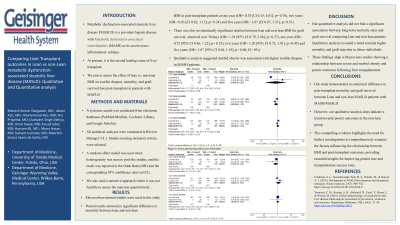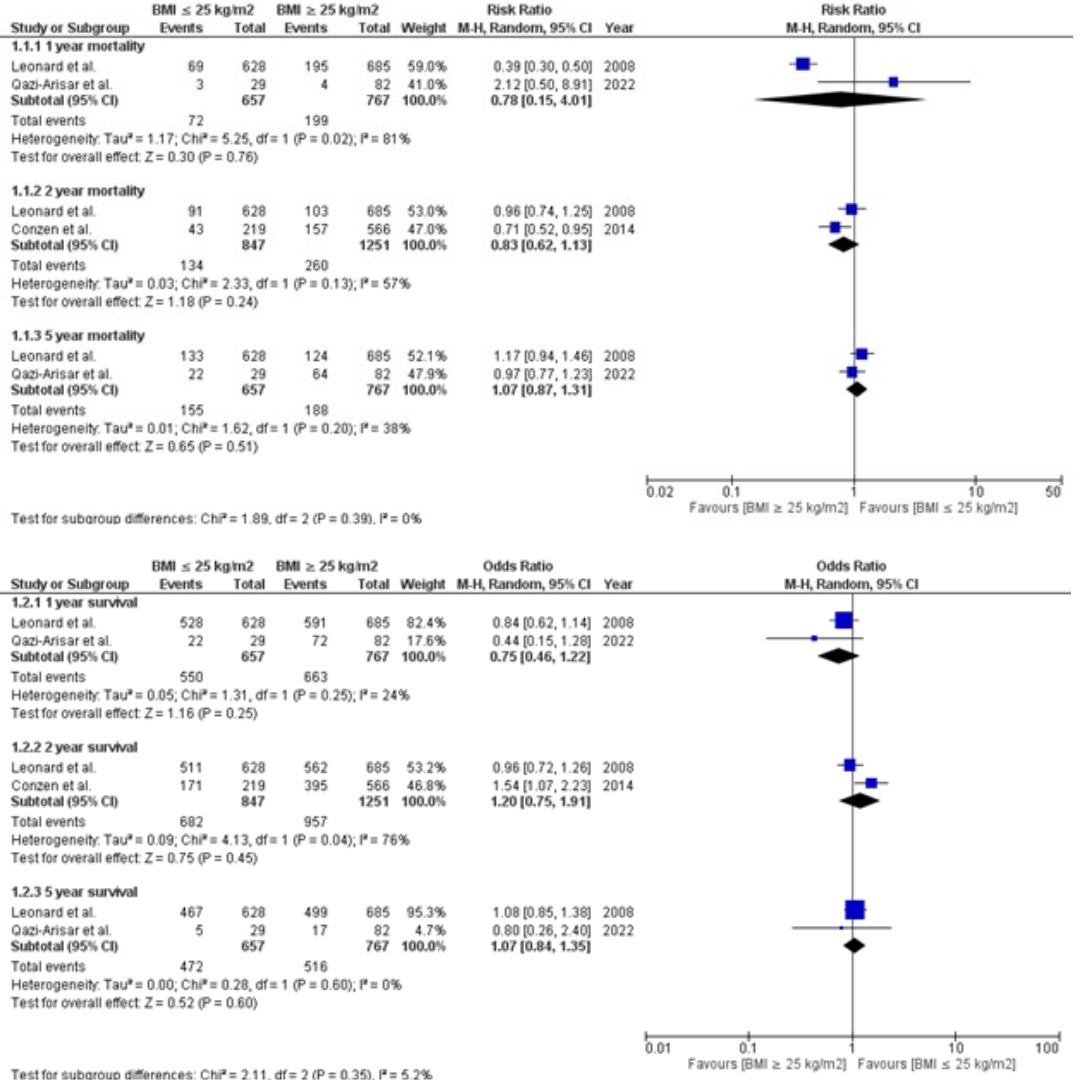Monday Poster Session
Category: Liver
P2354 - Assessing Liver Transplant Outcomes in Lean vs Non-Lean NAFLD Patients
Monday, October 23, 2023
10:30 AM - 4:15 PM PT
Location: Exhibit Hall

Has Audio

Umar Hayat, MD
Geisinger Wyoming Valley Medical Center
Wilkes-Barre, PA
Presenting Author(s)
Manesh Kumar Gangwani, MD1, Umar Hayat, MD2, Muhammad Aziz, MD1, Yusuf Nawras, 1, Dushyant Singh. Dahiya, MD3, Anooja Rani, 4, Abeer Aziz, MD5, Faisal Kamal, MD6
1University of Toledo, Toledo, OH; 2Geisinger Wyoming Valley Medical Center, Wilkes-Barre, PA; 3University of Kansas School of Medicine, Kansas City, KS; 4Dow University of Health Sciences, Karachi, Sindh, Pakistan; 5University of Augusta, Augusta, GA; 6Thomas Jefferson Health, Philadephia, PA
Introduction: Non-alcoholic steatohepatitis (NASH), a severe manifestation of non-alcoholic fatty liver disease (NAFLD), is the second leading indication for liver transplantation (LT). Current evidence in various studies regarding BMI (lean < 25 kg/m2, non-lean >25 kg/m2) and transplant outcomes is mixed. Therefore, we aim to assess the effect of pre-transplant BMI of NAFLD/NASH patients on mortality and graft survival.
Methods: A systemic search was conducted from electronic databases (PubMed/Medline, Cochrane Library, and Google Scholar) from inception to April 2023. All statistical analyses were conducted in Review Manager 5.4.1. Studies meeting inclusion criteria were selected. A random-effect model was used when heterogeneity was seen to pool the studies, and the result was reported in the Odds Ratio (OR)]and the corresponding 95% confidence interval (CI). We also used a narrative approach for qualitative assessment where it was not feasible to quantitatively assess the outcome due to incompatible analytical outputs.
Results: 11 observational studies were used in this study. Pooled results showed no statistically significant relationship between lean and non-lean BMI for post-transplantation mortality in 1 year (OR= 0.78 [95% CI 0.15, 4.01]; p= 0.76; I2= 81%), 2 year (OR= 0.83 [95% CI 0.62, 1.13]; p= 0.24; I2= 57%) and 5 year (OR= 1.07 [95% CI 0.87, 1.31]; p= 0.51; I2= 38%). There was also no statistically significant relation between lean and non-lean with graft survival, observed over 30 days (OR= 1.34 [95% CI 0.79, 2.26]; p= 0.27), 1 year (OR= 0.75 [95% CI 0.46, 1.22]; p= 0.25; I2= 24%), 2 years (OR= 1.20 [95% CI 0.75, 1.91]; p= 0.45; I2= 76%) and 5 years (OR= 1.07 [95% CI 0.84, 1.35]; p= 0.60; I2= 0%). The qualitative analysis indicated a higher rate of mortality and graft rejection in obese individuals but had high heterogeneity and variations in independent studies, limiting interpretability.
Discussion: This pooled statistical analysis determined no statistical difference in mortality or graft survival in lean vs non-lean patients undergoing LT suggesting BMI is not a significant predictor of long-term outcomes. More studies with multivariate regression analysis are needed for higher-powered analysis.

Disclosures:
Manesh Kumar Gangwani, MD1, Umar Hayat, MD2, Muhammad Aziz, MD1, Yusuf Nawras, 1, Dushyant Singh. Dahiya, MD3, Anooja Rani, 4, Abeer Aziz, MD5, Faisal Kamal, MD6. P2354 - Assessing Liver Transplant Outcomes in Lean vs Non-Lean NAFLD Patients, ACG 2023 Annual Scientific Meeting Abstracts. Vancouver, BC, Canada: American College of Gastroenterology.
1University of Toledo, Toledo, OH; 2Geisinger Wyoming Valley Medical Center, Wilkes-Barre, PA; 3University of Kansas School of Medicine, Kansas City, KS; 4Dow University of Health Sciences, Karachi, Sindh, Pakistan; 5University of Augusta, Augusta, GA; 6Thomas Jefferson Health, Philadephia, PA
Introduction: Non-alcoholic steatohepatitis (NASH), a severe manifestation of non-alcoholic fatty liver disease (NAFLD), is the second leading indication for liver transplantation (LT). Current evidence in various studies regarding BMI (lean < 25 kg/m2, non-lean >25 kg/m2) and transplant outcomes is mixed. Therefore, we aim to assess the effect of pre-transplant BMI of NAFLD/NASH patients on mortality and graft survival.
Methods: A systemic search was conducted from electronic databases (PubMed/Medline, Cochrane Library, and Google Scholar) from inception to April 2023. All statistical analyses were conducted in Review Manager 5.4.1. Studies meeting inclusion criteria were selected. A random-effect model was used when heterogeneity was seen to pool the studies, and the result was reported in the Odds Ratio (OR)]and the corresponding 95% confidence interval (CI). We also used a narrative approach for qualitative assessment where it was not feasible to quantitatively assess the outcome due to incompatible analytical outputs.
Results: 11 observational studies were used in this study. Pooled results showed no statistically significant relationship between lean and non-lean BMI for post-transplantation mortality in 1 year (OR= 0.78 [95% CI 0.15, 4.01]; p= 0.76; I2= 81%), 2 year (OR= 0.83 [95% CI 0.62, 1.13]; p= 0.24; I2= 57%) and 5 year (OR= 1.07 [95% CI 0.87, 1.31]; p= 0.51; I2= 38%). There was also no statistically significant relation between lean and non-lean with graft survival, observed over 30 days (OR= 1.34 [95% CI 0.79, 2.26]; p= 0.27), 1 year (OR= 0.75 [95% CI 0.46, 1.22]; p= 0.25; I2= 24%), 2 years (OR= 1.20 [95% CI 0.75, 1.91]; p= 0.45; I2= 76%) and 5 years (OR= 1.07 [95% CI 0.84, 1.35]; p= 0.60; I2= 0%). The qualitative analysis indicated a higher rate of mortality and graft rejection in obese individuals but had high heterogeneity and variations in independent studies, limiting interpretability.
Discussion: This pooled statistical analysis determined no statistical difference in mortality or graft survival in lean vs non-lean patients undergoing LT suggesting BMI is not a significant predictor of long-term outcomes. More studies with multivariate regression analysis are needed for higher-powered analysis.

Figure: Forest plot showing effect size of Mortality and Graft Survival
Disclosures:
Manesh Kumar Gangwani indicated no relevant financial relationships.
Umar Hayat indicated no relevant financial relationships.
Muhammad Aziz indicated no relevant financial relationships.
Yusuf Nawras indicated no relevant financial relationships.
Dushyant Dahiya indicated no relevant financial relationships.
Anooja Rani indicated no relevant financial relationships.
Abeer Aziz indicated no relevant financial relationships.
Faisal Kamal indicated no relevant financial relationships.
Manesh Kumar Gangwani, MD1, Umar Hayat, MD2, Muhammad Aziz, MD1, Yusuf Nawras, 1, Dushyant Singh. Dahiya, MD3, Anooja Rani, 4, Abeer Aziz, MD5, Faisal Kamal, MD6. P2354 - Assessing Liver Transplant Outcomes in Lean vs Non-Lean NAFLD Patients, ACG 2023 Annual Scientific Meeting Abstracts. Vancouver, BC, Canada: American College of Gastroenterology.
